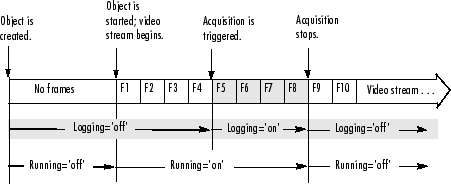Data Logging
Overview
When a trigger occurs, the toolbox sets the object's Logging property
to 'on' and starts storing the acquired frames
in a buffer in memory, a disk file, or both. When the acquisition
stops, the toolbox sets the object's Logging property
to 'off'.
The following figure illustrates when an object moves into a logging state and the relation between running and logging states.
Logging State Transitions

Note
After Logging is set to 'off',
it is possible that the object might still be logging data to disk.
To determine when disk logging is complete, check the value of the DiskLoggerFrameCount property.
For more information, see Logging Image Data to Disk.
The following figure illustrates a group of frames being acquired from the video stream and being logged to memory and disk.
Overview of Data Logging

Trigger Properties
The video input object supports several properties that you
can use to configure aspects of trigger execution. Some of these properties
return information about triggers. For example, to find out when the
first trigger occurred, look at the value of the InitialTriggerTime property.
Other properties enable you to control trigger behavior. For example,
you use the TriggerRepeat property to specify how
many additional times an object should execute a trigger.
The following table provides a brief description of all the trigger-related properties supported by the video input object. For information about how to set these properties, see Setting the Values of Trigger Properties.
Property | Description |
|---|---|
| Reports the absolute time when the first trigger executed. |
| Specifies the condition that must be met for a trigger
to be executed. This property is always set to |
| Specifies the callback function to execute when a trigger occurs. For more information about callbacks, see Using Events and Callbacks. |
| Specifies the number of frames to skip before logging data to memory, disk, or both. For more information, see Delaying Data Logging After a Trigger. |
| Specifies the number of additional times to execute a
trigger. If the value of |
| Reports the number of triggers that have been executed. |
| Specifies the source to monitor for a trigger condition
to be met. This property is always set to |
| Specifies the type of trigger: |
Note
To get a list of options you can use on a function, press the Tab key after entering a function on the MATLAB® command line. The list expands, and you can scroll to choose a property or value.